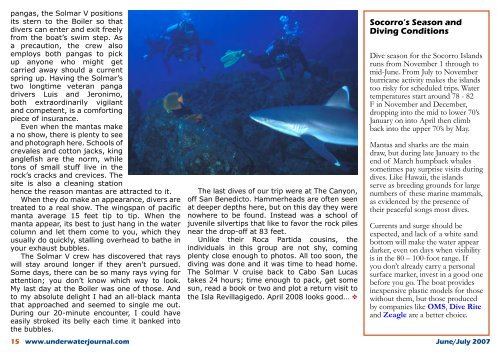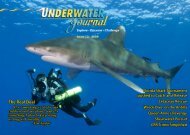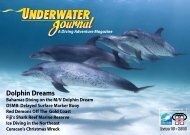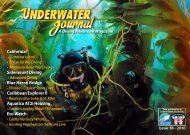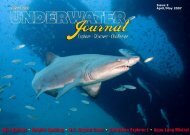- REBREATHERS - SPORT DIVERS ... - Stingray Divers
- REBREATHERS - SPORT DIVERS ... - Stingray Divers
- REBREATHERS - SPORT DIVERS ... - Stingray Divers
Create successful ePaper yourself
Turn your PDF publications into a flip-book with our unique Google optimized e-Paper software.
pangas, the Solmar V positions<br />
its stern to the Boiler so that<br />
divers can enter and exit freely<br />
from the boat’s swim step. As<br />
a precaution, the crew also<br />
employs both pangas to pick<br />
up anyone who might get<br />
carried away should a current<br />
spring up. Having the Solmar’s<br />
two longtime veteran panga<br />
drivers Luis and Jeronimo,<br />
both extraordinarily vigilant<br />
and competent, is a comforting<br />
piece of insurance.<br />
Even when the mantas make<br />
a no show, there is plenty to see<br />
and photograph here. Schools of<br />
crevales and cotton jacks, king<br />
anglefish are the norm, while<br />
tons of small stuff live in the<br />
rock’s cracks and crevices. The<br />
site is also a cleaning station<br />
hence the reason mantas are attracted to it.<br />
When they do make an appearance, divers are<br />
treated to a real show. The wingspan of pacific<br />
manta average 15 feet tip to tip. When the<br />
manta appear, its best to just hang in the water<br />
column and let them come to you, which they<br />
usually do quickly, stalling overhead to bathe in<br />
your exhaust bubbles.<br />
The Solmar V crew has discovered that rays<br />
will stay around longer if they aren’t pursued.<br />
Some days, there can be so many rays vying for<br />
attention; you don’t know which way to look.<br />
My last day at the Boiler was one of those. And<br />
to my absolute delight I had an all-black manta<br />
that approached and seemed to single me out.<br />
During our 20-minute encounter, I could have<br />
easily stroked its belly each time it banked into<br />
the bubbles.<br />
The last dives of our trip were at The Canyon,<br />
off San Benedicto. Hammerheads are often seen<br />
at deeper depths here, but on this day they were<br />
nowhere to be found. Instead was a school of<br />
juvenile silvertips that like to favor the rock piles<br />
near the drop-off at 83 feet.<br />
Unlike their Roca Partida cousins, the<br />
individuals in this group are not shy, coming<br />
plenty close enough to photos. All too soon, the<br />
diving was done and it was time to head home.<br />
The Solmar V cruise back to Cabo San Lucas<br />
takes 24 hours; time enough to pack, get some<br />
sun, read a book or two and plot a return visit to<br />
the Isla Revillagigedo. April 2008 looks good... v<br />
Socorro’s Season and<br />
diving Conditions<br />
Dive season for the Socorro Islands<br />
runs from November 1 through to<br />
mid-June. From July to November<br />
hurricane activity makes the islands<br />
too risky for scheduled trips. Water<br />
temperatures start around 78 - 82<br />
F in November and December,<br />
dropping into the mid to lower 70’s<br />
January on into April then climb<br />
back into the upper 70’s by May.<br />
Mantas and sharks are the main<br />
draw, but during late January to the<br />
end of March humpback whales<br />
sometimes pay surprise visits during<br />
dives. Like Hawaii, the islands<br />
serve as breeding grounds for large<br />
numbers of these marine mammals,<br />
as evidenced by the presence of<br />
their peaceful songs most dives.<br />
Currents and surge should be<br />
expected, and lack of a white sand<br />
bottom will make the water appear<br />
darker, even on days when visibility<br />
is in the 80 – 100-foot range. If<br />
you don’t already carry a personal<br />
surface marker, invest in a good one<br />
before you go. The boat provides<br />
inexpensive plastic models for those<br />
without them, but those produced<br />
by companies like OMS, Dive Rite<br />
and Zeagle are a better choice.<br />
www.underwaterjournal.com June/July 2007


